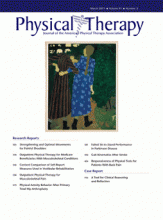Abstract
Background and Purpose Professional development is a cornerstone of physical therapist practice. As the profession moves toward the ideals of Vision 2020, more emphasis is being placed on the process of clinical decision making. Although reflection and mentorship are widely regarded as important instruments to facilitate the progression of clinical reasoning skills, little guidance exists in the postprofessional arena to assist clinicians with these essential needs. As more organizations develop formal mentoring programs, a need arises for a tool that will engage mentors, protégés, and clinicians of all abilities in thoughtful reflection and discussion that will help develop clinical reasoning skills.
Case Description The process of developing reflective clinical decision-making skills in physical therapist practitioners is described, and how this process was used at one institution is illustrated. A tool for clinical reasoning and reflection is proposed that incorporates the existing conceptual frameworks of the Guide to Physical Therapist Practice and the International Classification of Functioning, Disability and Health (ICF).
Outcomes This case report discusses how the tool was implemented by staff with varying levels of expertise, their outcomes in regard to the development of their clinical reasoning skills, and how the tool facilitated mentoring sessions around patient cases to improve care.
Discussion This case report describes a practical application of a postprofessional educational process designed to develop reflective and patient-centered clinical reasoning skills. Although this process has shown some preliminary success, more research is warranted. By cultivating reflective thinking and critical inquiry, the physical therapy profession can help develop autonomous practitioners of physical therapy and promote the ideals of Vision 2020.
Footnotes
Dr Atkinson and Dr Nixon-Cave provided concept/idea/project design and writing.
Part of the manuscript, including the PT-CRT Tool, was presented by both authors at an educational session at the Combined Sections Meeting of the American Physical Therapy Association; February 11, 2011; New Orleans, Louisiana.
- Received July 7, 2009.
- Accepted November 11, 2010.












